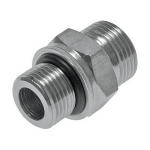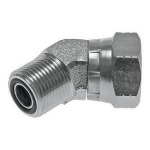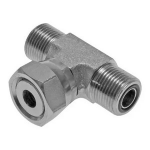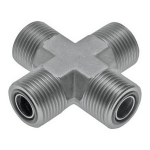Email:johnny@jazzyindustrial.com
Mob: +8613957800923
Rm. (5-2), Bldg. 045, No. 163, Ruiqing Road, Yinzhou Dist., Ningbo, Zhejiang, China
Email:johnny@jazzyindustrial.com
Mob: +8613957800923
Rm. (5-2), Bldg. 045, No. 163, Ruiqing Road, Yinzhou Dist., Ningbo, Zhejiang, China
Views: 2 Author: Tameson Publish Time: 2023-07-24 Origin: Tameson









Hydraulic fittings come in a wide range of types and applications. They are used to connect the hydraulic hose to components like hydraulic cylinders, pipes, tubes, or different types of hydraulic hoses in hydraulic systems.
The different types of hydraulic fittings allow the fluid to flow, change its direction, divert, or mix. These fittings should be capable of creating a tight seal and preventing leakage in the application. These fittings are widely used in hydraulic-powered applications including plumbing, robotics, assembly lines, and heavy equipment.
Hydraulic fitting types
Common hydraulic fluids
Selection Criteria & points of attention
How to properly connect to a hydraulic hose
Common applications
Hydraulic fitting charts
Other fitting articles
FAQ
The following types of hydraulic fitting types are used widely in the European and US market:
ORFS: ORFS (O-Ring Face Seal) fittings have an O-ring groove at the flat face of the fitting. Sealing for such fittings is achieved by connecting the O-ring with the flat face of the female connector. These fittings are ideal for high-pressure applications and provide a leakage-free connection. ORFS fittings can be of the following types:
| Straight ORFS fitting | Straight screw connection with male ORFS connection point to male NPT, G or metric threads |  |
| Elbow ORFS fitting | Elbow screw connection with one ORFS female connection and another ORFS male connection at an angle |  |
| Tee ORFS fitting | T- shaped screw connection with one female ORFS connection port and two male ORFS connection ports |  |
| Cross ORFS fitting | Four male ORFS connection ports in a cross-orientation, useful for distributing or combining the media |  |
These ORFS fittings are generally accompanied by accessories such as plugs, end caps, O-rings.
DIN/ BSP: DIN (Deutsches Institut für Normung) and BSP (British Standard Pipe) fittings are commonly used hydraulic fitting types in Europe.
DIN fittings ensure interchangeability with different brands of fittings and are used in industrial, construction, and oil and bag industries.
BSP fittings conform to BSP standards for screw threads. They are used for sealing and interconnecting pipes and can be achieved by interlocking external (male) thread with internal (female) thread. They are mostly used in plumbing industries and are widely accepted except for North America, where NPT standards are used.
Hydraulic fittings are used to seal the hydraulic oil or fluid within the system. Thus, the fittings should be compatible with the fluid being used. Hydraulic fluid provides the energy to the system allowing the machinery to perform its work. There are different types of hydraulic media in the market.
Petroleum-based fluids: Petroleum or mineral-based fluid is the most used hydraulic fluid. Additives in such fluids provide protection from rust and oxidation, wear and tear, corrosion, and extreme pressure. These fluids are generally high quality, low cost, and widely available.
Water-based fluids: These fluids have high water content, so, they are used for fire-resistance. They are available as water-in-oil emulsions, oil-in-water emulsions, and water-glycol blends. They are more expensive than petroleum-based fluids and have lower wear resistance.
Synthetic-based fluids: These fluids are man-made and provide advantages like fire-resistance, lower friction, and thermal stability. They are ideal to use in high-temperature and high-pressure applications due to their excellent lubricating property. However, they are more expensive than petroleum-based fluids and maybe slightly toxic.
The following criteria should be considered before selecting the correct hydraulic fitting types for your application:
Size: The internal and external diameter of the fittings are two important sizes to consider. These diameters of the fitting should be compatible with the hose diameter. Over or under-sized fittings can cause leakage or the connection to fail.
Material: The material of the hydraulic fitting should be compatible with the hydraulic fluid and with the operating environment. The most commonly used fitting materials are brass, aluminum, steel, or stainless steel. NBR (Nitrile) O-rings are the most widely used sealing materials.
Temperature: The hydraulic fittings should be suitable for your temperature range.
Pressure: The hydraulic fittings must be suitable for your pressure range, including the pressure spikes. Operating beyond this range can cause damage to the fittings.
Application: The type of application also determines the fitting type to be used. Tee- or cross- fittings are used for mixing or distribution application.
Assembly: If the hydraulic system requires frequent connecting and disconnecting of the hose or tube, the hydraulic quick-connect fittings can be used. Similarly, hydraulic compression fittings can be used to remove the need for welding or soldering of the fitting. It uses a compression nut to tighten against the ferrule creating a very tight seal. It can be used in areas with high temperatures as welded joints can leak in such environments.
To properly connect the hydraulic hose with the hydraulic fitting:
Ensure the length of the hose is as required. Hose cutters can be used to cut it to the optimal size with clean ends to reduce the risk of contamination and assembly failures.
Select the appropriate hydraulic hose fitting. Make sure to consider size, pressure, temperature, material, style, and orientation of the fitting is compatible with your operation.
Determine the insertion depth of the fitting and mark it on the hose with a marker. Lubricate the hose (if necessary) and insert the hose into the fitting until the mark on the hose.
Adjust the crimper to the appropriate diameter, place the end of the hose in the crimping machine and crimp the hose.
Verify the crimp diameter.
Clean the hose assembly to avoid contamination using a hose brush.
Hydraulic fittings are used for piping and tubing with hydraulic hoses in the following applications:
Factory applications like assembly lines, presses, robotics, hydraulic power units
Construction and mining equipment
Agricultural equipment
Plumbing applications
Oil and gas industry
©️ Ningbo Jazzy Industrial Co., Ltd.